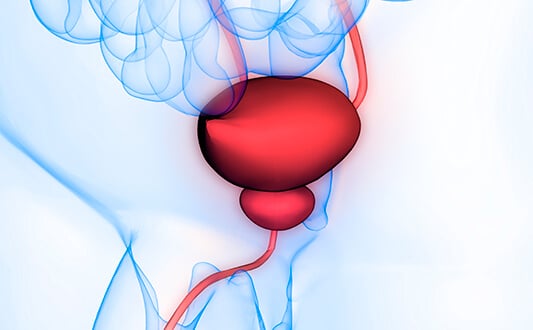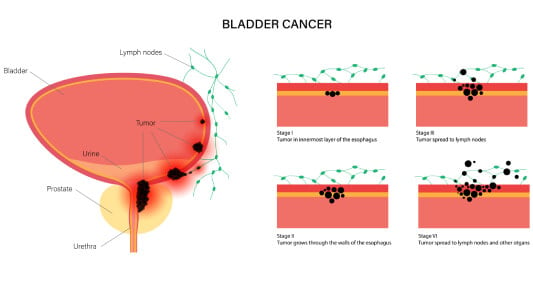Bladder cancer is one of the most common cancers worldwide, affecting both men and women, though men are significantly more likely to be diagnosed. According to the U.S. National Cancer Institute, an estimated 84,870 new cases of bladder cancer have been diagnosed in the United States in 2024 alone, with approximately 17,420 related deaths expected during the same year [1]. While early-stage bladder cancer is often treatable, recurrence rates remain high, and many patients face repeated interventions over their lifetime.
Because of these challenges, the global medical community continues to search for more effective and personalized approaches. Traditional treatments such as surgery and intravesical therapy have long been the standard of care, but in recent years, advances in immunotherapy, targeted treatments, and minimally invasive surgical techniques have opened up new possibilities - especially for patients with advanced or recurrent disease.
Symptoms and Early Warning Signs of Bladder Cancer
Bladder cancer doesn’t always shout - it often whispers. The earliest symptoms can seem minor or mimic more common conditions like urinary tract infections. Yet behind these signs could be a growing tumor, which is why early recognition is key.
The most consistent red flag is visible blood in the urine (gross hematuria), which occurs in the majority of cases. But sometimes, the bleeding is microscopic and detected only through testing. Patients may also experience urinary urgency, painful urination, or unexplained lower abdominal discomfort. These signs, while less specific, can still point toward underlying malignancy - especially when they persist or recur.
A major primary care study published in the British Journal of General Practice [2] found that visible hematuria had the highest predictive value for bladder cancer, while non-visible hematuria, dysuria, and abdominal pain also carried diagnostic weight, particularly when occurring together. This reinforces the importance of not dismissing urinary symptoms, especially in older adults or long-term smokers.
Stages and Classification of Bladder Cancer
Bladder cancer isn’t a single disease - it comes in many forms and degrees of severity. That’s why proper staging and classification are so essential: they shape the entire course of treatment and affect long-term outcomes. At the time of diagnosis, doctors assess both how deeply the tumor has grown into the bladder wall and whether it has spread to nearby or distant areas. Staging helps determine whether a patient will need local therapies or more aggressive treatment.
Histological Types of Bladder Cancer
Before diving into staging, it’s important to understand that bladder cancer isn’t a single disease. Under the microscope, tumors can look very different depending on which cells they originated from - and this can dramatically affect both treatment and prognosis.
The most common form is urothelial carcinoma (also known as transitional cell carcinoma), which accounts for about 90% of all bladder cancer cases in industrialized countries. These tumors develop from the urothelial cells lining the inside of the bladder and can appear as either superficial or invasive, low-grade or high-grade. Urothelial carcinoma is also the type most likely to recur, which is why long-term surveillance is often necessary.
Stages of Bladder Cancer
Once the type is determined, doctors use a standardized staging system - usually TNM, which stands for Tumor size/depth, Node involvement, and Metastasis. These are grouped into stages I to IV, each one representing a deeper level of invasion and spread.
- Stage I: The cancer has grown into the connective tissue just beneath the bladder lining (T1), but not yet into the muscle.
- Stage II: The tumor has invaded the muscular wall of the bladder (T2).
- Stage III: The tumor extends beyond the bladder wall into surrounding tissues like the fat around the bladder or nearby organs (such as the prostate in men or the uterus in women). It may also involve nearby lymph nodes (T3 or T4a, N0–1).
- Stage IV: The cancer has spread even further—to the abdominal or pelvic wall, distant lymph nodes, or organs such as the lungs, bones, or liver.
To stage the cancer accurately is crucial because it not only reflects the extent of disease progression but also helps doctors define treatment goals - curative when possible, or life-extending and symptom-relieving when it’s not.
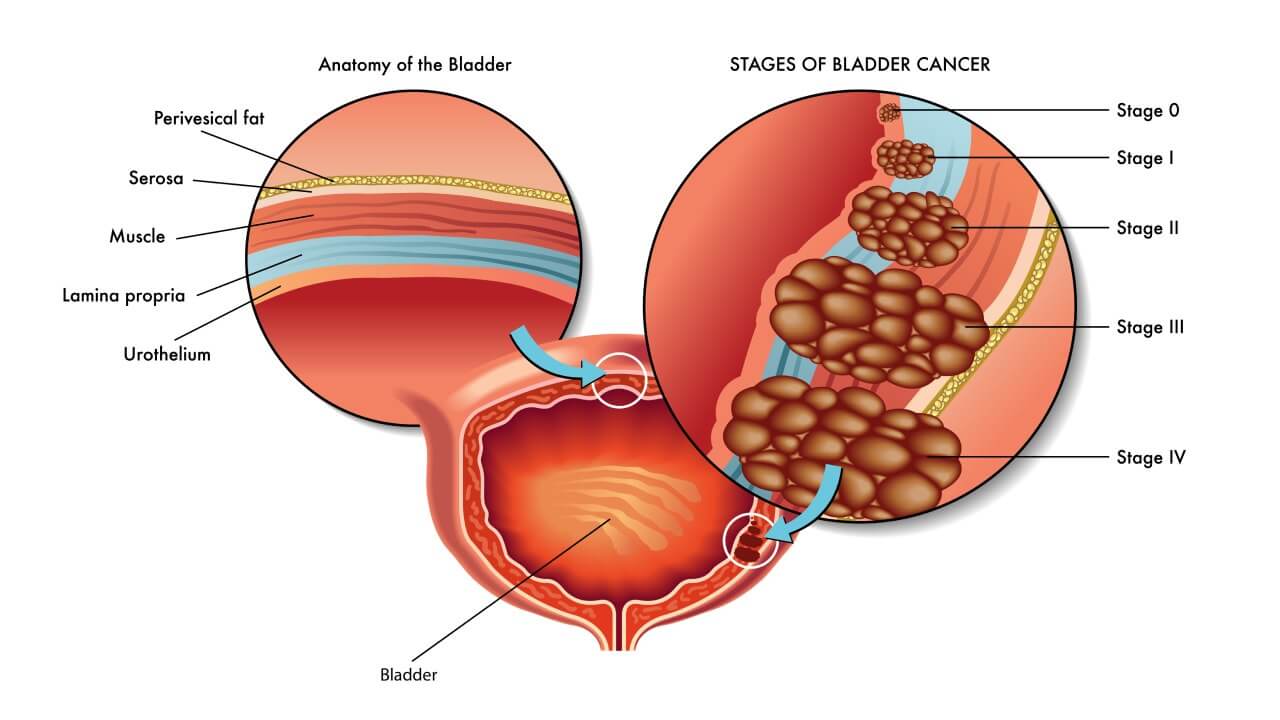
Diagnostic Methods for Bladder Cancer
Accurate diagnosis is the cornerstone of effective bladder cancer treatment. Because symptoms can be subtle or mimic other urinary conditions, doctors rely on a combination of diagnostic tools to confirm the presence of cancer, determine its extent, and plan the best course of action.
Cystoscopy and Biopsy in Bladder Cancer
The gold standard for bladder cancer diagnosis is cystoscopy—a procedure where a thin, flexible tube equipped with a camera (a cystoscope) is inserted through the urethra to examine the bladder lining directly. This allows the urologist to spot suspicious lesions or tumors in real time.
If abnormalities are found, a biopsy is performed during cystoscopy. Small tissue samples are collected and sent to the lab for histological analysis, which confirms the cancer type and grade. Biopsy results guide treatment decisions and staging.
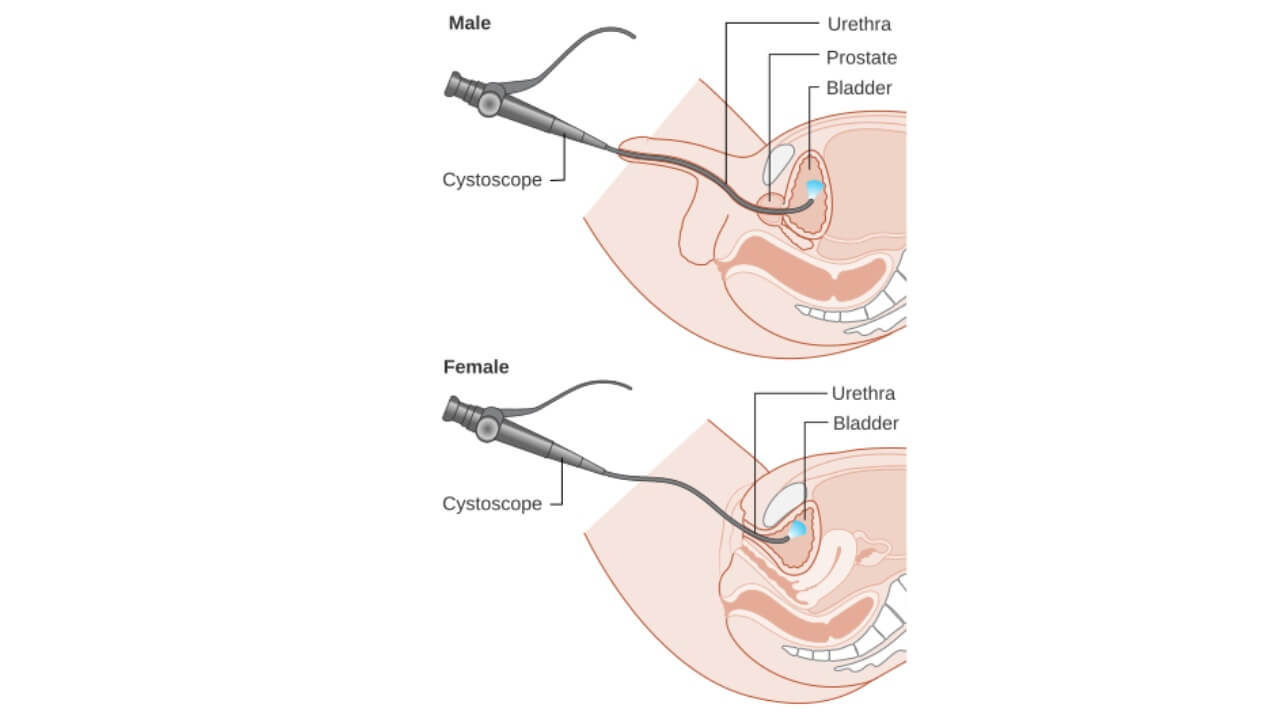
Imaging Techniques in Bladder Cancer: CT, MRI, and PET-CT
To understand how far the cancer has spread, imaging plays a vital role:
- Computed Tomography (CT) scans provide detailed cross-sectional images of the bladder and surrounding organs, helping detect tumor invasion into muscle or nearby tissues, as well as lymph node involvement.
- Magnetic Resonance Imaging (MRI) offers excellent soft tissue contrast and is especially useful for evaluating the depth of tumor invasion and involvement of adjacent structures without radiation exposure.
- Positron Emission Tomography combined with CT (PET-CT) is increasingly used for detecting distant metastases and assessing the whole body for cancer spread, providing functional imaging that complements anatomical scans.
While cystoscopy gives a direct view of the bladder, imaging is what reveals the bigger picture. It shows whether the cancer has stayed local or moved beyond, which is essential for proper staging [3]. In many cases, multiple imaging modalities are used together to ensure nothing is missed—especially in patients with high-grade or muscle-invasive tumors.
Urological Laboratory Tests in Bladder Cancer
Alongside imaging and endoscopic evaluations, several lab tests support diagnosis and monitoring:
- Urinalysis detects blood or abnormal cells in the urine.
- Urine cytology examines urine samples under a microscope to identify cancer cells shed from the bladder lining.
- Urine-based biomarkers are also emerging to improve early detection, though they are not yet widely standardized.
These laboratory tools are often the first signal that something is wrong, especially in patients with microscopic hematuria or vague urinary symptoms. Although they can’t replace cystoscopy, they’re a valuable part of the diagnostic toolkit—particularly for follow-up and ongoing monitoring.
Treatment Options for Bladder Cancer
The choice of treatment for bladder cancer depends on many factors - including the stage of the disease, the type of tumor, and the patient’s overall health. In general, treatment strategies fall into two categories: established standard-of-care methods and newer, more innovative therapies that are often available through specialized or international clinics.
While early-stage cancers may be treated locally, more advanced or recurrent tumors often require a combination of systemic and locoregional approaches. Here’s how modern bladder cancer care is evolving.
Standard Treatment Approaches for Bladder Cancer
For decades, the core treatment options for bladder cancer have centered on surgery (cystectomy), chemotherapy, and radiotherapy. These remain the backbone of care in most hospitals around the world.
- Surgery: For non-muscle-invasive tumors, transurethral resection of the bladder tumor (TURBT) is often the first step. In more advanced stages, radical cystectomy - complete removal of the bladder - is performed, sometimes with lymph node dissection and urinary reconstruction.
- Intravesical Therapy: After TURBT, patients with superficial bladder cancer often receive intravesical BCG or chemotherapy instillations directly into the bladder to prevent recurrence and progression.
- Systemic Chemotherapy: For muscle-invasive or metastatic cases, chemotherapy remains the gold standard. It is often used either before cystectomy (neoadjuvant) or after (adjuvant), and sometimes as primary treatment for inoperable disease—often combined with radiation therapy.
- Radiation Therapy: In patients who cannot undergo surgery or choose bladder-sparing approaches, radiation therapy - often combined with chemotherapy - can be used to control the tumor and preserve bladder function.
These standard therapies have helped thousands of patients worldwide - but they also come with side effects, limitations, and, in some cases, a high risk of relapse. That’s where innovation comes in.
Innovative and Targeted Therapies for Bladder Cancer
As oncology moves toward bladder cancer treatment is expanding beyond surgery and chemotherapy. New non-invasive bladder cancer treatment now aims to boost the immune system, deliver chemotherapy with greater precision, and reduce toxicity.
Dendritic Cell Therapy for Bladder Cancer
One of the most promising breakthroughs in bladder cancer stage 4 treatment is dendritic cell therapy - a form of personalized immunotherapy designed to reawaken the immune system's ability to detect and destroy cancer.
Here’s how it works: immune cells are collected from the patient’s blood and exposed in the lab to antigens from their own tumor. These "trained" cells are then re-injected into the patient to activate cytotoxic T-cells, which can identify and attack bladder cancer cells throughout the body.
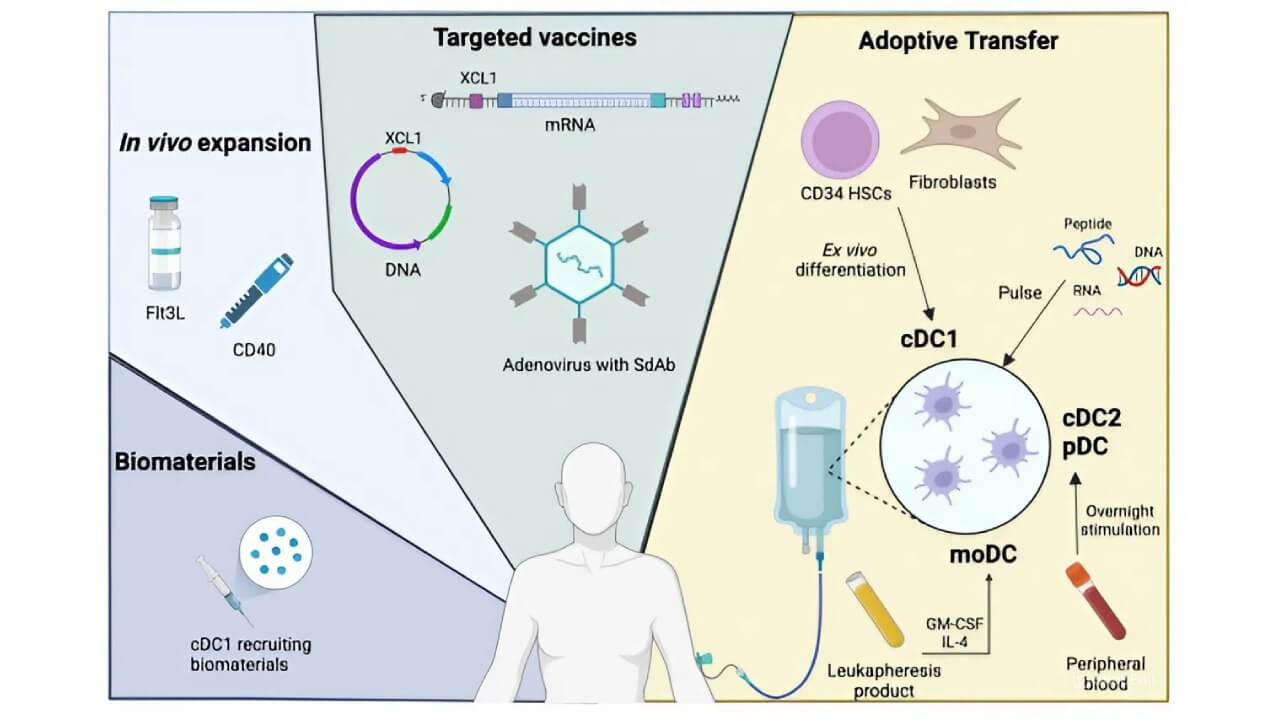
The science behind this method is not new - it builds on a discovery that earned immunologist Ralph Steinman the Nobel Prize in Physiology or Medicine in 2011, for identifying dendritic cells and uncovering their central role in regulating immune responses [5]. Today, that foundational research is being transformed into a real-world therapy that offers hope to patients who have limited options with standard treatments.
This approach has several advantages:
- It uses the patient’s own biology, minimizing the risk of rejection.
- It’s highly targeted, meaning fewer systemic side effects.
- It may work even in late-stage or recurrent cases where traditional treatments have failed.
While still considered an advanced treatment, excellent clinical results suggest improved survival in select patients—especially when combined with other therapies.
Transarterial Chemoembolization (TACE) for Bladder Cancer
TACE is a minimally invasive procedure that delivers chemotherapy directly into the arteries feeding the tumor, then immediately blocks those arteries to trap the drug and cut off the cancer’s oxygen supply. While traditionally used for liver tumors, TACE is becoming an important option in bladder cancer stage 4 treatment, especially for patients who are not candidates for cystectomy.
Benefits of TACE:
- Localized impact: Because the drug stays concentrated in the tumor area, higher doses can be used without overwhelming the rest of the body.
- Reduced systemic toxicity: Patients typically experience fewer side effects than with intravenous chemotherapy.
- Palliative potential: In patients with large, inoperable pelvic tumors, TACE can help shrink the mass, relieve pressure, and make future treatments (like cystectomy or immunotherapy) more feasible.
This technique, performed by interventional radiologists, has become a powerful option for treating bladder tumors that are difficult to remove surgically or have not responded to standard chemotherapy.
Other Targeted and Immune-Based Options for Bladder Cancer
In addition to dendritic cell therapy and TACE, several other innovative approaches are helping push bladder cancer treatment into a new era:
- Immune checkpoint inhibitors work by blocking PD-1/PD-L1 pathways—releasing the "brakes" on the immune system so it can attack the tumor more effectively. This method is often used after initial non-invasive bladder cancer treatment has been tried, offering a powerful next step when needed.
- FGFR-targeted therapies offer hope for patients whose tumors carry FGFR2 or FGFR3 mutations. These drugs directly interfere with growth signals that cancer cells rely on, complementing options available for non-invasive bladder cancer treatment and more advanced disease.
- Hyperthermic intravesical chemotherapy (HIVEC) combines heated chemotherapy with local delivery into the bladder, increasing absorption and cytotoxic effect while minimizing systemic exposure.
- Isolated pelvic perfusion and regional chemotherapy techniques deliver high-dose drugs to the pelvic area with minimal exposure to other organs.
These therapies are now being used in specialized oncology centers—often as part of personalized treatment programs for patients with advanced or treatment-resistant bladder cancer. While not yet part of every national guideline, they are increasingly integrated into care plans at leading hospitals and offer real options for patients looking beyond conventional protocols. For many, these approaches provide new hope where standard treatments have reached their limits.
| Therapy Type | 2-Year Survival Rate | Response Rate | Duration | Side Effects |
|---|---|---|---|---|
| Standard Treatments | ~55-70% for early stages ~30% for advanced stages | ~40-60% | Several weeks to months | Moderate to severe (fatigue, nausea, infertility, bowel/bladder issues) |
| Innovative Methods | ~60-75% in select advanced/refractory cases | 45-65% | Up to 4-6 sessions | Mild (fever, localized inflammation, flu-like symptoms) |
*Based on Booking Health clinical data and published outcomes. Actual results may vary depending on patient condition and treatment protocol.
Treatment of Bladder Cancer
For patients diagnosed with bladder cancer, especially those facing complex or advanced cases, access to accurate diagnostics and innovative therapies can be the deciding factor between standard outcomes and a real chance at recovery. Today, more people are choosing to undergo bladder tumor therapy in Germany—not just because of the reputation of its hospitals, but because of the results they consistently deliver.
From the very beginning, bladder cancer diagnosis in Germany follows a detailed and multidisciplinary protocol. High-resolution imaging tools like PET-CT, MRI, and contrast-enhanced CT scans allow for precise tumor staging, while biopsy results and molecular profiling help doctors determine the most effective course of action. This kind of detailed workup is essential, whether the patient presents with non-invasive bladder cancer or has already progressed to bladder cancer stage 4.
Non-Invasive to Advanced: Full-Spectrum Bladder Cancer Treatment Options
For early-stage tumors, German specialists offer conservative, bladder-sparing approaches such as TURBT (transurethral resection of bladder tumor) followed by intravesical immunotherapy. These methods aim to control the disease while preserving bladder function and quality of life.
At the same time, bladder cancer in Germany is treated with access to advanced options like chemoembolization, regional chemotherapy, and dendritic cell immunotherapy - methods that are integrated into routine clinical care at leading centers.
Patients with bladder cancer stage 4 can benefit from a range of therapies, including dendritic cell therapy, TACE, and combination protocols that are adapted to the individual tumor profile. Rather than a one-size-fits-all plan, treatment of bladder cancer in Germany is shaped around the biology of the disease and the patient’s response, making it more effective and better tolerated.
International patients seeking treatment for bladder cancer in Germany often rely on Booking Health, an official medical facilitator that works directly with the country’s leading clinics. Their support streamlines every step—from medical translation and case evaluation to hospital admission and aftercare—ensuring patients receive advanced bladder tumor therapy in a well-organized, patient-friendly way.
| Treatment Methods | Germany | Great Britain | USA |
|---|---|---|---|
| Standard Treatments | €80,000-€150,000 full course | €90,000-€165,000 full course | €100,000-€180,000 full course |
| Innovative Methods | €25,000-€60,000 full course | €70,000-€120,000 full course | €100,000-€150,000 full course |
*Based on pricing insights from Booking Health. Final treatment costs may vary depending on individual clinical factors, length of hospital stay, required post-treatment supervision, and additional services such as diagnostics, travel assistance, and accommodation logistics.
A Journey of Strength and Recovery from Bladder Cancer

When Yehia Mahmoud Hanafy Ibrahim was diagnosed with bladder cancer, he and his family began searching for a treatment option that would offer both medical excellence and human support. Like many international patients, they were looking for more than just procedures and protocols – they wanted guidance, reassurance, and someone they could rely on from start to finish.
With help from Booking Health, Yehia was able to start treatment in one of Germany’s leading oncology centers. The coordination team took care of everything – from confirming medical appointments to organizing transfers and answering questions along the way. What stood out most to Yehia and his family was not just the professionalism but the feeling that they were never alone in the process.
He later shared how much it meant to have someone like Nour from the Booking Health team handling every detail with care and consistency. The support continued not only through the clinical phase but right up until the final day of their stay. Yehia summed up his experience by saying how grateful they were for the team’s help throughout the entire medical journey, and how they would remain in contact even after returning home.
Stories like Yehia’s remind us that cancer care is never just about the treatment itself - it’s about people. It’s about trust, clarity, and knowing that someone is walking the path with you.
A Medical Journey: Every Step of the Way With Booking Health
Finding the best treatment strategy for your clinical situation is a challenging task. Being already exhausted from multiple treatment sessions, having consulted numerous specialists, and having tried various therapeutic interventions, you may be lost in all the information given by the doctors. In such a situation, it is easy to choose a first-hand option or to follow standardized therapeutic protocols with a long list of adverse effects instead of selecting highly specialized innovative treatment options.
To make an informed choice and get a personalized cancer management plan, which will be tailored to your specific clinical situation, consult medical experts at Booking Health. Being at the forefront of offering the latest medical innovations for already 12 years, Booking Health possesses solid expertise in creating complex cancer management programs in each individual case. As a reputable company, Booking Health offers personalized stage 4 bladder cancer treatment plans with direct clinic booking and full support at every stage, from organizational processes to assistance during treatment. We provide:
- Assessment and analysis of medical reports
- Development of the medical care program
- Selection of a suitable treatment location
- Preparation of medical documents and forwarding to a suitable clinic
- Preparatory consultations with clinicians for the development of medical care programs
- Expert advice during the hospital stay
- Follow-up care after the patient returns to their native country after completing the medical care program
- Taking care of formalities as part of the preparation for the medical care program
- Coordination and organization of the patient's stay in a foreign country
- Assistance with visas and tickets
- A personal coordinator and interpreter with 24/7 support
- Transparent budgeting with no hidden costs
Health is an invaluable aspect of our lives. Delegating management of something so fragile yet precious should be done only to experts with proven experience and a reputation. Booking Health is a trustworthy partner who assists you in pursuing stronger health and a better quality of life. Contact our medical consultant to learn more about the possibilities of personalized treatment with innovative methods for metastatic bladder cancer with leading specialists in this field.
Fighting Cancer Together: Treatment Journeys with Booking Health
Frequently Asked Questions of Our Patients About Bladder Cancer
Send request for treatmentThe most common early signs include blood in urine, frequent urination, and discomfort. Detecting blood in urine early is crucial. If you notice these symptoms, consult a specialist for prompt evaluation and diagnosis.
Diagnosis involves urine tests, cystoscopy to visualize the bladder, biopsy to confirm cancer cells, and imaging like CT or MRI scans. Early diagnosis helps tailor treatment and improves outcomes.
Stage 1 often involves non-invasive bladder cancer treatment like TURBT and immunotherapy. Stage 4 requires more complex therapies, including systemic immunotherapy and experimental approaches. Treatment coordination ensures personalized care.
Yes, non-invasive bladder cancer treatment aims to preserve the bladder using TURBT, intravesical therapies, and immunotherapy. Advanced cases may need surgery, but bladder-sparing experimental approaches exist.
Costs vary by stage and treatment type. Germany’s top clinics offer transparent pricing and support for international patients, including treatment coordination, legal support, and transfer assistance.
Top clinics in Germany lead hospital rankings for bladder cancer care, offering advanced diagnostics and treatments. International patients benefit from expert teams and comprehensive support.
Dendritic cell therapy is an innovative immunotherapy that enhances immune activation to target cancer cells more effectively. It is offered in leading German centers for patients with advanced bladder cancer.
For bladder cancer, full-course costs show Germany ~€80,000-€150,000 for standard treatments and €25,000-€60,000 for innovative methods; Great Britain ~€90,000-€165,000 and €70,000-€120,000; USA ~€100,000-€180,000 and €100,000-€150,000. In Australia, by contrast, access to innovative options is more limited and often 3-4 times more expensive.
Standard treatments for bladder cancer can provide ~55-70% in early stages and ~30% in advanced disease at 2 years. On the other hand, innovative methods (e.g., dendritic cell therapy, interventional radiology techniques, etc.) report ~60-75% in select cases.
Patients can expect ~40-60% response with standard treatments for bladder cancer, compared with 45-65% using innovative methods (e.g., interventional and immunologic approaches).
Standard bladder cancer treatments usually run several weeks to months (multiple cycles). In turn, innovative methods (e.g., TACE, dendritic cell therapy, etc.) are commonly completed in up to 4-6 sessions.
Standard bladder cancer treatments often cause moderate to severe effects (fatigue, nausea, infertility, bowel/bladder issues). However, innovative methods generally lead to mild effects (fever, localized inflammation, flu-like symptoms).
Choose treatment abroad and you will be sure to get the best results!
Authors:
This article was edited by medical experts, board-certified doctors Dr. Nadezhda Ivanisova, and Dr. Bohdan Mykhalniuk. For the treatment of the conditions referred to in the article, you must consult a doctor; the information in the article is not intended for self-medication!
Our editorial policy, which details our commitment to accuracy and transparency, is available here. Click this link to review our policies.
Sources:
[1] National Cancer Institute. Cancer Stat Facts: Bladder Cancer. https://seer.cancer.gov/statfacts/html/urinb.html
[2] PubMed. Non-visible versus visible haematuria and bladder cancer risk: a study of electronic records in primary care. https://pubmed.ncbi.nlm.nih.gov/25179073/
[3] PubMed. Cystoscopy Accuracy in Detecting Bladder Tumors: A Prospective Video-Confirmed Study. https://pubmed.ncbi.nlm.nih.gov/38201586/
[4] PubMed. Dendritic cell subsets and implications for cancer immunotherapy. https://pubmed.ncbi.nlm.nih.gov/30641919/
[5] Nobel Prize. The Nobel Prize in Physiology or Medicine 2011 – Ralph Steinman. https://www.nobelprize.org/prizes/medicine/2011/steinman/facts/
[6] Wikipedia. Diagram showing a cystoscopy for a man and a woman.
Read:
New Effective Treatments for Stage 4 Cancer: Innovations in Oncology
Stage 4 Bladder Cancer: Comprehensive Guide and Treatment Options
Article menu:
- Symptoms and Early Warning Signs of Bladder Cancer
- Stages and Classification of Bladder Cancer
- Diagnostic Methods for Bladder Cancer
- Treatment Options for Bladder Cancer
- Treatment of Bladder Cancer
- A Journey of Strength and Recovery from Bladder Cancer
- A Medical Journey: Every Step of the Way With Booking Health
- Frequently Asked Questions of Our Patients About Bladder Cancer
Don't know where to start?
Contact Booking Health








